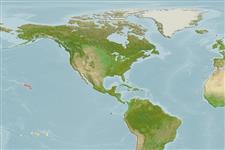>
Clupeiformes (Herrings) >
Dorosomatidae (Gizzard shads and sardinellas)
Etymology: Sardinella: Latin and Greek, sarda = sardine; name related to the island of Sardinia; diminutive (Ref. 45335).
Environment: milieu / Klimaatzone / Diepte / distribution range
Ecologie
marien pelagic-neritic; diepte 0 - 50 m (Ref. 188). Tropical; 24°N - 19°S, 164°W - 141°W (Ref. 188)
Eastern Pacific: endemic to the Marquesas Islands. Introduced into Hawaiian waters.
Grootte / Gewicht / Leeftijd
Maturiteit: Lm ? range ? - ? cm
Max length : 16.0 cm SL mannelijk / geslacht onbekend; (Ref. 54980); common length : 10.0 cm SL mannelijk / geslacht onbekend; (Ref. 188)
Dorsale stekels (totaal) : 0; Dorsale zachte stralen (totaal) : 13 - 21; Anale stekels: 0; Anale zachte stralen: 12 - 23. Body slender; total scutes 28 to 30; lower gill rakers strongly increasing with size of fish, about 45 at 5 or 6 cm standard length, 50 to 80 (maximum) at 6 to 10 cm. Vertical striae on scales not meeting at center, no perforations on hind part of scale. No dark spot at dorsal fin origin, no dark tips to caudal fin. Can be separated from other species by a combination of above characters.
Body shape (shape guide): fusiform / normal; Cross section: compressed.
Pelagic (Ref. 58302). Forms schools in coastal waters. Dominant species in beach seine hauls. Used as tuna bait (Ref. 6822). First reported case of clupeoid poisoning was in 1978 in the Hawaiian Is., probably caused by a planktonic dinoflagellate (Ref. 45133).
Levenscyclus en paargedrag
Maturiteit | Voortplanting | Paaien | Eieren | Fecunditeit | Larven
Whitehead, P.J.P., 1985. FAO Species Catalogue. Vol. 7. Clupeoid fishes of the world (suborder Clupeoidei). An annotated and illustrated catalogue of the herrings, sardines, pilchards, sprats, shads, anchovies and wolf-herrings. FAO Fish. Synop. 125(7/1):1-303. Rome: FAO. (Ref. 188)
Status op de Rode Lijst van het IUCN (Ref. 130435: Version 2025-1)
Gebruik door de mens
Visserij: visserij voor eigen gebruik; aas: usually
Tools
Speciale rapporten
Download XML
Internetbronnen
Estimates based on models
Preferred temperature (Ref.
123201): 25.1 - 28.8, mean 27.5 °C (based on 63 cells).
Fylogenetische diversiteitsindex (Ref.
82804): PD
50 = 0.5000 [Uniqueness, from 0.5 = low to 2.0 = high].
Bayesian length-weight: a=0.00851 (0.00399 - 0.01817), b=3.05 (2.88 - 3.22), in cm total length, based on LWR estimates for this Genus-body shape (Ref.
93245).
Weerstandsvermogen (Ref.
120179): Hoog, minimale populatieverdubbelingstijd minder dan 15 maanden (Preliminary K or Fecundity.).
Fishing Vulnerability (Ref.
59153): Low vulnerability (10 of 100).
🛈
